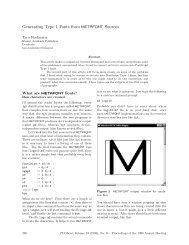Linear Differential Game With Two Pursuers and One Evader
Linear Differential Game With Two Pursuers and One Evader
Linear Differential Game With Two Pursuers and One Evader
You also want an ePaper? Increase the reach of your titles
YUMPU automatically turns print PDFs into web optimized ePapers that Google loves.
ZEM<br />
z ( θ ) =<br />
2<br />
τ<br />
P<br />
a E max<br />
The Zero Effort Miss distance is given below for DGL/1:<br />
2<br />
2 ⎛θ<br />
⎞<br />
ZEM ( t)<br />
= y + y&<br />
t − && y τ h( θ ) + & y<br />
go P P<br />
E<br />
τ<br />
E<br />
h⎜<br />
⎟<br />
⎝ ε ⎠<br />
Where y is the relative perpendicular miss, y& the relative perpendicular velocity, & y& P<br />
the<br />
(instantaneous) perpendicular pursuer acceleration <strong>and</strong> & y&<br />
E<br />
the perpendicular evader acceleration. The<br />
non-dimensional cost function is the normalized terminal miss distance subject to minimization by the<br />
pursuer <strong>and</strong> maximization by the evader.<br />
= z = z θ = 0<br />
J<br />
f<br />
( t)<br />
( )<br />
The (ZEM, Tgo) frame is divided into two regions, the regular area <strong>and</strong> the singular one. For some<br />
appropriated differential game parameters (pursuer to evader maximum acceleration ratio μ <strong>and</strong> evader<br />
to pursuer time lag ratio ε), the singular area plays the role of capture zone so called also NEZ (leading<br />
to zero terminal miss), whilst the regular area corresponds to the non capture zone. The NEZ can be<br />
bounded (closed) or unbounded (open). The natural optimal strategies are bang-bang controls<br />
corresponding to the sign of ZEM (some refinements exist when defining optimal controls inside the<br />
NEZ). We start the 2x1 DGL/1 analysis with unbounded 1x1 NEZ as pictured in Figure 1 (NEZ<br />
delimited by the two plain red lines, non capture zone corresponding to the state space filled with<br />
optimal trajectories in dot blue lines). Moreover, we first assume same Tgo in each DGL/1 game<br />
(same initial range, same velocity for each pursuer).<br />
300<br />
DGL/1, μ = 3.6, ε = 0.8, με = 2.88<br />
200<br />
100<br />
z * + (τ)<br />
normalized z<br />
0<br />
-100<br />
z * - (τ)<br />
-200<br />
-300<br />
0 5 10 15<br />
normalized tgo<br />
Figure 1 : Unbounded NEZ (ZEM, Tgo frame)<br />
3. <strong>Two</strong> pursuers one evader DGL/1 game<br />
3.1. Criterion<br />
The outcome we consider in the 2x1 game is the minimum of the two terminal miss distances.<br />
<strong>With</strong> J the terminal miss,<br />
i<br />
( u u , v) min { J ( u , v) , J ( u v)<br />
}<br />
J x<br />
,<br />
2 1 1, 2<br />
=<br />
1<br />
2<br />
u the control of Pi , = { 1, 2}<br />
( u v)<br />
( u v)<br />
( u u v)<br />
i <strong>and</strong> v the evader control.<br />
J<br />
1<br />
, : P1 E DGL/1 terminal miss<br />
J<br />
2<br />
, : P2 E DGL/1 terminal miss<br />
J<br />
2 x 1 1,<br />
2,<br />
: 2x1 DGL/1 outcome<br />
- 2 -







